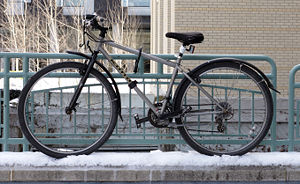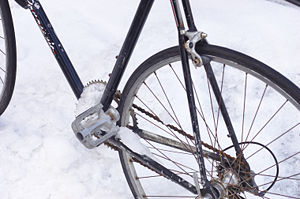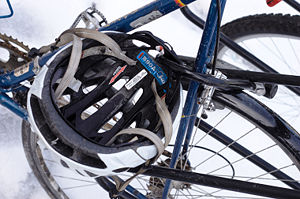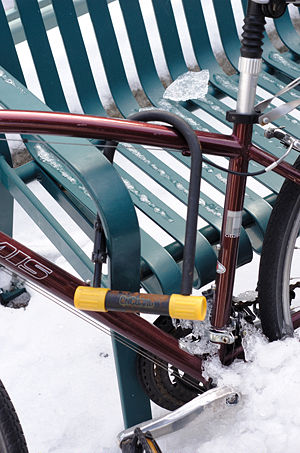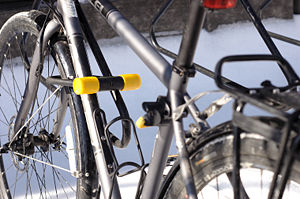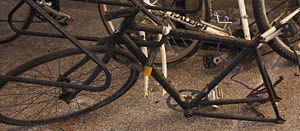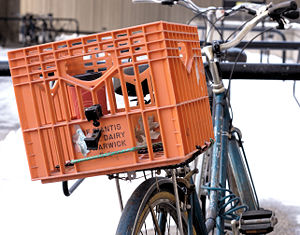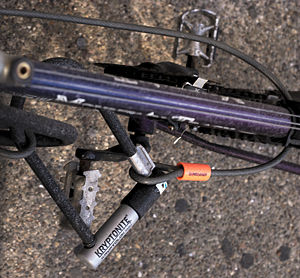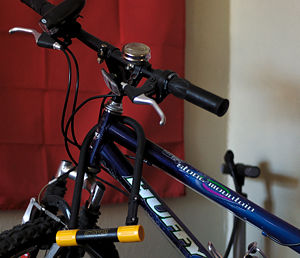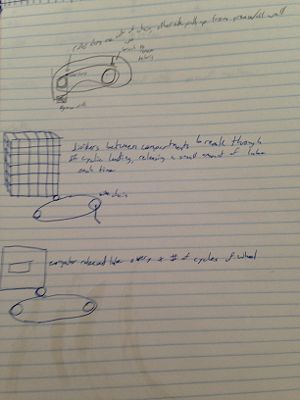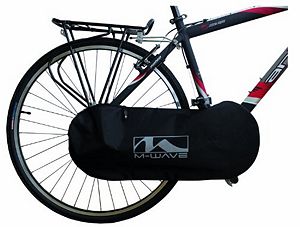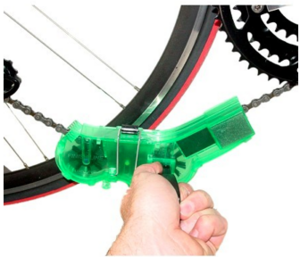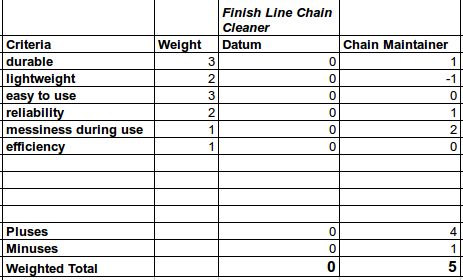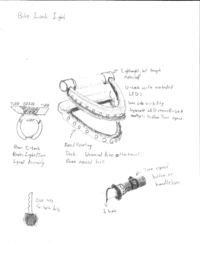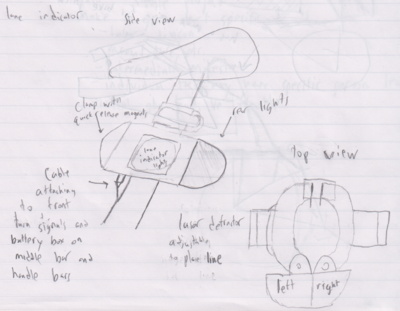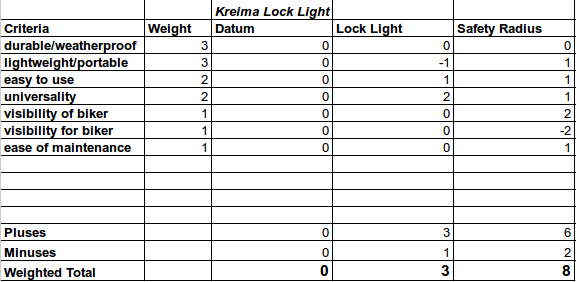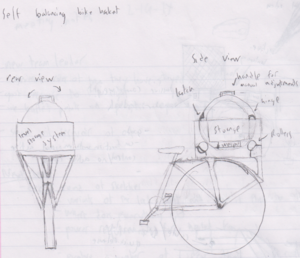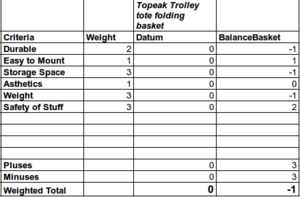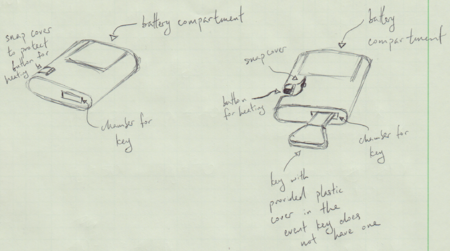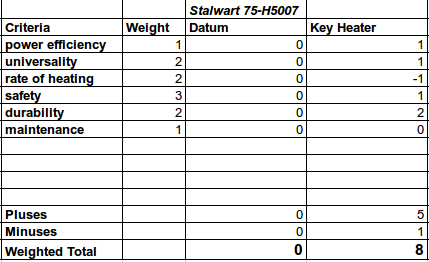Bike lock opportunity
From DDL Wiki
Contents |
Executive Summary
The intent of phase two of this project is to identify an opportunity for a new product starting off with knowledge we gained during phase one. We entered the market research phase taking a look at how users interact with their bikes and locks. Between the observational studies, stakeholder interviews, hands-on experience disassembling bikes, and survey, we learned a lot about how people felt about bikes. The results of our market research pointed us to conceptualizing a product in one of a few different areas in the realm of bicycles. Most notably, these were safety, security, and maintenance. Research showed that people wanted a bike lock that was lighter than current locks, but did not sacrifice any security. Locks also needed to be more weatherproof, especially during the winter. We learned that for drivers, visibility of cyclists of night is an area that needs improvement. Repair shops told us that the least maintained part of a bicycle is the chain, which is susceptible to grime and rust, and that lights are most commonly stolen off of parked bikes. Another potential area of improvement identified during our brainstorming and observational studies were on-bike storage systems. These systems quite often jostled contained items around, which could lead to breakage or spills.
Using these research conclusions, we came up with one hundred ideas, dispersed among a set of categories relevant to bicycles. After much deliberation, we ended up with five ideas that seemed to address some of these major needs. First we came up with a transmission casing that would fit onto many styles of bike transmissions and provide protection from the elements as well as offering some active lubrication. This makes the transmission more maintenance free. Our next idea was to winter-proof a lock by creating a small key heater for your key chain. The next idea addresses the issue of bike storage with a self balancing basket. To address bicycle security, we came up with a U-Lock light system. Lights were commonly stolen off of locked up bikes because the lights had no form of protection. Building a light into a lock addresses that issue as well as visibility issues. The final concept was a device that would create a safety radius around the bike, communicating to drivers what a safe following and passing distance is.
Through the use of Pugh charts and discussion on which idea was sufficiently complex for this class, as well as what would be most interesting to work on, we have decided to pursue the fabrication of the Lock Light. We feel that this concept will address the largest areas we identified: safety and security through combining a lightweight lock with a lighting package that helps both the cyclist and other road users.
Market Research
Observational Studies
We went around Carnegie Mellon's campus and into University of Pittsburgh's campus to study how users locked up their bikes. We noticed many interesting things, listed below.
The main takeaways of this study are:
- Users have come up with ways to deal with shortcomings of existing products.
- Bike transmissions are not very weatherproof and require a lot of maintenance that people do not typically do.
- Few people use the provided mounting bracket to store their lock on their bike. Some designs will not fit every bike.
- People will lock their bikes to anything available that is secure enough.
Stakeholder Interviews
Specialty Bike and Repair Shops | ProBikes and Free Ride PGH (Expert Interview)
From talking to ProBikes, we learned that the most commonly sold bike was a hybrid bike (a mix between a mountain and a road bike), which is useful as a daily commuter and for casual riding. The most popular accessory, by far, was lights, and the most uncommon item or most difficult to find item was a rear derailleur hanger. This is because there are many different types and styles. There is no standard, so year, brand, and frame geometry all factor into what type of rear derailleur hanger you need. The biggest complaint with bikes relates to shifting gears. Chains are either not lubricated, over lubricated, rusted, or they mis-shift. This failure generally falls on the user of the bike because they do not maintain their bike drive train properly. Maintenance issues were usually due to mileage, but the biggest mileage independent wear item was tires. Flat tires always happen and people come in asking for help with that. Maintenance items include tire levers, which help remove the tire from the hub, and inner tubes for tires. People are still afraid of using these items by themselves though, so they have the shop do it for them. Generally, the most stolen items are seat posts and lights. People do not seem to take just tires anymore; they take the whole bike. The shop employees said they wanted a lightweight and easy to carry lock that was still secure.
Visiting Free Ride PGH gave us the opportunity to take apart and dissect bicycles. This gave us hands-on experience with the tools required for bicycle maintenance, which is what Free Ride PGH suggested we look into improving. Two pieces of equipment, in particular, that they would like to have are an improved chain breaking tool and a seat post remover. The current chain breaker tool that is in use, while simple, is hard to use properly, which results in a number of broken chain breaking tools, and currently, there is no effective way to remove a rusted seat post from the frame of the bike. Having a rusted seat post that is stuck to the frame of the bike prevents the user from adjusting the seat in any way, which could render the bike potentially useless. Other items that Free Ride PGH discussed with us were electrically powered bike accessories, in particular lights. They mentioned that easily installed and uninstalled lights are essential and that currently, many lights have an issue where they are easily triggered through light bumps. This leads to the potential of the lights accidentally being left on and running out of power.
Locksmith | Squirrel Hill Locksmith and Hardware (Expert Interview)
While the locksmith was out on call, another store employee was able to provide us with useful information regarding their business. Most of their work comes from replacing keys in old (100+ year old) houses. At this point it seems some lock components wear out. Generally, the locksmith only gets about 3 calls a year about bike locks and usually just cuts them with bolt cutters, if possible. Picking a bike lock is rarely performed, at least by this shop. The most secure type of lock is made by a company called Mul-T-lock. They are marketed as undrillable, unpickable, and if you break a key in them, you must replace the whole door. There are smaller variants of this type of lock. The key has an odd shape and is nearly impossible to easily machine. You have to call the company with a special number to verify that you are the owner of the lock if you need a replacement key. The locksmith’s hint for environmental protection was to spritz some WD-40 into your lock every once in a while. It will flush out dirt and grime and not leave a residue. It also helps prevent freezing.
Carnegie Mellon Cycling Team/Club (User Interview)
To get more informed comments and suggestions regarding bike locks and accessories, we contacted Carnegie Mellon’s Cycling Team and Club. Because they regularly ride bicycles and are more knowledgeable on the subject of bicycles, we thought that talking with them would be beneficial. When conversing with them we asked them to give their comments and suggestions about bike locks and other bike accessories, bike accessories that should exist but don’t yet, and the bike itself. What we learned is that they, just like the rest of the population who took the survey, have the same complaints and suggestions regarding bike locks. They want a bike lock that is more portable and has a better carrying attachment, does not scratch the bike frame, and is lighter but still strong and secure. They also informed us of two bike locks, the TiGr Lock and Hiplok, that work well. The TiGr Lock is a lightweight titanium bicycle lock that is long enough to lock both wheels and the frame. The Hiplok is a fabric covered chain lock that can be carried by the rider’s hips while cycling. We learned that in addition to a standard cable or U-Lock, they also used locking skewers. Most bikes today are equipped with quick release front and back wheels and seats, meaning that they are easy targets when not locked. Locking skewers replace the quick release wheel and seat skewers to prevent theft of these items. Based on a description from Peter White Cycles' website, each skewer has its own uniquely shaped nut and a matching key so a standard wrench would not be able to loosen the nut. When hearing their comments about other existing bike accessories we learned that they felt that there is room for improvement in multiple areas. The comments and suggestions we received for this area include: mounting tires is a pain, work stands and storage for bikes could be improved, the integration of turn and brake signals into bike locks, a higher factor of safety on helmets, an improved attachment system for panniers, and a solar powered bike light. When asked to come up with a bike accessory they would want that does not exist, we received suggestions such as, a bike dashboard, heated handlebars, and a car horn for bikes. Finally, we asked them if there could be any improvements done to the bicycle itself. The only suggestion we received was to design an anti-lock braking system to prevent the brakes from locking up and skidding.
Retail Stores | Target and Dick's Sporting Goods
Our experience with talking to the store employees and corporate offices was generally unhelpful. They avoided giving us their opinion on which products they believed were superior to others and stated to us that all their available products should be sufficient for our purposes. This was very different compared to the advice we received from our other stakeholder interviews. Through our observations of their merchandise, however, we were able to find some inspiration. The retail stores' selection of bike accessories while not as high quality as those of specialty bike shops did feature some interesting variations that we didn't see in the specialty bike shops. For example, we found extra long cable locks for locking multiple bike locks together, and we saw a flexible U-Lock.
Carnegie Mellon University Campus Police
The CMU Campus Police provided us with information on what they suggested as good bike practices, such as using U-Locks over cable locks and registering your bike. They also reported that most thefts on campus occur because people do not lock their bikes at all.
Survey Results
Through the survey, we asked people about the type of bike lock they use, how and where they lock their bikes, basic demographic information about themselves, and asked them for anything they wish was different about their bike lock or other available products. We determined that most people use a U-lock, or a U-lock and a cable in combination so that they can lock more parts of their bike at once. Even then, many questioned the security of existing locks and wished that they were easier to carry, lighter, and more secure. In general, nearly everyone polled said that they lock the frame of their bike, with extra locking measures or better locks being able to also lock one or both wheels as well as the frame. The exception to this was with international respondents, where they were more likely to use a lock that while it would prevent the bike from being ridden away would not prevent someone from picking up the bike and walking away with it.
Respondents
By splitting into age ranges, we found that our respondents fit fairly evenly into 3 age groups, one from 18-22, one from 22-29, and one 30 & above. The majority of respondents are daily riders from urban areas, and came from 9 countries around the world, although primarily US residents. The most important contributions from our survey are summarized in the graphs below. The set of survey questions can be found in the Appendix.

| 
|

| 
|
Research Conclusions
From our extensive research, we were able to refine our previous list of stakeholder needs. Below is a table listing what we believe are the most important stakeholder needs.
| Stakeholder Needs |
|
Design Concepts
Chain Maintenance Casing
This design consists of an attached chain guard, to protect the chain from dust and other road debris, that will also periodically oil the chain for the user without any user input or action. There will be a roller over one section of the chain, likely near the derailleur, that would apply the lubricant to the center of the chain where it can then soak into internals of the chain. The lubricant will be dispensed by a cartridge attached near the roller. This cartridge would either be a mechanical system of many chambers that will be broken by increasing amounts of cyclic loading, with each chamber breaking and releasing a small amount of lubrication periodically. The other option for the cartridge is to have a small powered system that tracks how many rotations the chain has made and after some x number of rotations, likely in the thousands, it will release an amount of lube appropriate to coat the chain.
The risks of this design are that it will be very hard to make a universal system, as bike drive trains have a large amount of variation, and the difficulty in properly storing and releasing lubricant in such a way that when applied it will not splatter the user.
Comparable products include the current chain guards that form a case around the bike chain to protect it from road debris and weather while simultaneously protecting a user from possible injury or fall due to a pant leg getting caught in the chain, such as the first image above, and attachable chain greasers that are attached periodically and temporarily to clean the chain and then removed, as in the second above below.
Above is a Pugh chart comparing our chain maintenance casing to the Finish Line competitor product. Although these products are not exactly similar, they do have a lot of commonalities. We tried to compare them based on criteria that were applicable to both. By our comparison, as shown above, the chain maintenance casing has its advantages over the competition, especially in terms of messiness. The Finish Line product drips and wastes a lot of oil. This is something we hope to correct with our chain lubrication solution.
Lock and Light Combo
This concept utilizes a main universal mounting bracket around the bike's handlebars. This mounting bracket will manage the light controls as well as house the batteries and house the U-Lock. The Lock will have LED's embedded in it, some designated for a headlight and some designated for front turn signals. The mounting bracket will contain lenses for focusing the headlamps.
There will also be a secondary lock on the back of the bike, over the rear wheel. It is a C-Lock, commonly used in The Netherlands. This lock works by jamming a pin between the spokes of the rear wheel, preventing rotation, making stealing a bike somewhat more difficult. We will integrate this lock with more lighting: a brake light and rear turn signals.
This concept is driven by the results of market research that stated that people tend to have their lights stolen fairly often, since no one takes them inside with them. We also address the issue of bike safety by having a proper lighting package for cyclists, giving them increased visibility and a greater ability to show their intent to other road users at night. Building the lighting package into the lock prevents the light from being stolen while the bike is parked.
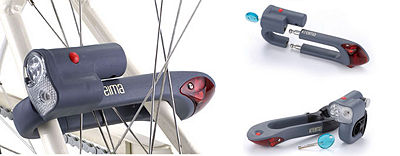
Relatively new product on market from Taiwanese design company. Lock weighs about 1.4lbs, looks to be a hard plastic casing over some form of steel backbone. Lock features include bright LED front lights and high-positioned rear light. Rear light does not act as brake light and there are no turn signals. Mounting is accomplished through two places: a ring on the seat post for the rear light and a mount on the handlebars for the headlight. With this product, the tail light has its own separate mounting point. Our idea is less complex in that the rear lights are fixed, though we will have some form of control signal running from the front of the bike to the back to handle turn signals and braking.
The Pugh chart for this idea is contained in the following section, since the two ideas are similar enough that comparison to one product is not far-fetched.
Safety Radius
In some states, such as Colorado and Oregon, drivers of motor vehicles that wish to pass a bicycle travelling in the same direction must pass the bicycle with a space of at least 3 feet between the vehicle and bicycle, as seen in the overview of bicycle laws by AAA. While this provides cyclists with a safety buffer, it is difficult, especially at night, for motorists to gauge the distance between their vehicle and the bicycle accurately causing some vehicles to pass too close to the bicycle. The purpose of the bike lane indicator light is to project light onto the pavement around the cyclist to create a virtual bike lane for the cyclist. This way, drivers have a better sense of the size of the safety buffer to give cyclists when passing.
When searching online for existing products, we found that there have been many concepts for a bike lane indicator light but few actual products that work well. In addition to projecting a virtual bike lane, the concepts and existing products also act as a taillight. Some complaints found on Amazon that existing products have received include: the lights are too dim to see from a car, the battery life is really short, they are cheaply made, installation is difficult, and they are bulky. Based on these reviews on an existing product, there is room for improvement. In addition to being a taillight and bike lane indicator light, the product could also be turn signals and/or brake lights, which many people requested during our market research. Other possible ideas are to somehow have an indicator that lets the cyclist know if a car is within their 3 foot safety zone, have the ability to turn off one side of the lane if there are only cars on one side of the cyclist to save battery, have the ability to change the angle at which the light points due to the variable bike lane widths caused by the different mounting heights, and have a rechargeable battery.
![Concept: LightLane, Clamps onto the seat post and acts as a taillight and virtual bike lane [1] source](/ddl/images/thumb/Light-lane.jpg/300px-Light-lane.jpg) Concept: LightLane, Clamps onto the seat post and acts as a taillight and virtual bike lane [1] source | ![Concept: Bike Zone, Clamps onto the handlebar stem and acts as a taillight, virtual bike lane, and turn signals [2] source](/ddl/images/thumb/Bikezone_01.jpg/300px-Bikezone_01.jpg) Concept: Bike Zone, Clamps onto the handlebar stem and acts as a taillight, virtual bike lane, and turn signals [2] source | ![Existing Product: X-Fire, Clamps onto the seat post and acts as a taillight and virtual bike lane [3] source](/ddl/images/thumb/Xfire.jpg/200px-Xfire.jpg) Existing Product: X-Fire, Clamps onto the seat post and acts as a taillight and virtual bike lane [3] source |
For this concept, we chose to mount it just under the seat of a bike. This area is often used by simple rear indicator lights and provides an excellent stable mount point that is roughly centered on the bike. To hold to the seat post, the two sides will be brought near enough for a central magnetic coupling clamp to hold the two sides in place. Once fixed in place, the rear lights can be turned on, receiving both an on signal and turn signals from buttons attached to the handle bars and wired back to the safety radius device. Lastly, to produce the safety lanes, a set of adjustable lasers with diffractors will produce a line that can be adjusted to match the requirements of the law or the rider. This is visible as the protruding cylinders in the sketch that help make the safety radius device.
The above Pugh chart compares the our Lock Light concept, our safety radius concept, and an existing lock light, as shown in the previous section. Our major criteria were lightweight and durable, determined from the results of our market research. The safety radius came out on top of this match-up because it would be permanently fixed to the bike, where the locks will be moved about to serve their purpose as locks.
Self-Balancing Bike Basket
For this concept, we attempted to fill a need we noticed among people attempting to carry larger and more cumbersome objects that could not be easily placed into a backpack or normal carrying crate. Especially when we looked at the many objects a student tries to carry with them, many of these objects most be carried carefully, not jostled about during transportation, as well as their orientation must be maintained. But, we noticed that with the current means of carrying objects on a bike, objects are prone to tipping over in the bag or falling out as the rider leans and turns. Our concept for a self-balancing bicycle basket comes from this need to transport items on a bicycle without tipping them over, potentially causing extra harm or damage.
For our solution, the self-balancing basket attaches just like a normal basket wood, by fixing to an extension on the frame above the rear wheel and just behind the seat. All of the items being carried would sit within a spherically shaped chamber that sits atop a set of rollers, allowing the sphere to change its orientation relative to the bike freely. By weighting the bottom of the spherical chamber, this chamber will then always remain upright relative to gravity even as the biker pitches and rolls the bike. Thus the chamber will passively remain upright, keeping the contents from tipping over as the rider transports them.
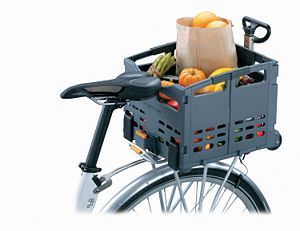 Topeak Trolley Tote Folding Basket, source:source |
Our self-balancing basket is competing directly with existing rear bike baskets, such as the Topeak Trolley tote folding basket. This basket, easily found on Amazon, is a very durable plastic frame atop a metal bike mount, making it both lighter and more spacious than our self-balancing basket. But the main premise of our self-balancing basket is the protection it provides to spill-able and more sensitive materials being transported. Thus, as seen in our Pugh chart analysis, the self-balancing basket must make some trade-offs in carrying capacity, weight, and complexity to achieve its goals of better item protection.
Heated Key/Lock De-Icer
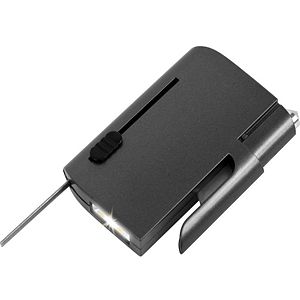 Stalwart 75-H5007 5-in-1 Auto Tool Kit. A competitor's heated key/lock de-icer design. Source: Amazon.com |
From the survey results and from interactions with everyday bike users, we found that a big issue for bikes and bike accessories is coping with winter weather and temperatures. There were several comments regarding bike locks freezing making them very difficult to use, and there was a demand for making the overall bike riding system more weatherproof. As such, this design concept was generated in order to combat the issue of frozen locks and to help fulfill at least one part of the stakeholder need of making the bike riding system more weatherproof. With the heated key product, a user would be more comfortable using his or her bike and bike lock year round. It reduces the fear and concern of not being able to open your bike lock because the locking mechanism is frozen.
Overall, the product is a simple system. It will be handheld and have a chamber that will be heated through resistive heating. The power will come from two AA batteries, and the user simply has to insert his or her bike key into the chamber and press a button to complete the circuit and begin the heating. The heating button is sheltered by a simple hinged snap cover to prevent accidental contact, and after a couple of minutes, the key will be heated due to conduction and radiation. The key can then be removed and inserted into the lock to thaw the frozen locking mechanism allowing for proper operation of the lock. An insulated key cover will also be provided in case the user does not have one on his or her key. This will protect the user from the heating of the key and device.
With regards to competitor products, there are several similar competitor products made for car locks. They are of similar style: handheld and battery powered. The biggest difference is that these competitor products do not heat the key but a small metal rod that protrudes from the end of the device. This prong is used to de-ice the lock, and then, the user can insert his or her key to operate the lock. Some of these products contain added features, such as a flashlight, but from user reviews posted on Amazon.com, these devices seem to be unreliable and cheaply made. One complaint is that the heating button can be easily pressed when carrying the product in a purse or in the user's pocket, which drains the batteries and is possibly a hazard because of the unintentional heating. This is why our design includes a snap cover over the heating button. Another complaint is the durability of the product. There have been cases where the prong has snapped off. This is what pushed us to remove any thin metal protrusions and opt to heat the key directly.
Final Design Concept
Our final concept we selected was the lock and light combination. It scored fairly well on our Pugh chart analysis and it encompasses a fair number of mechanically complex issues that we believe we can overcome to build a viable final product. But, our analysis also showed that the safety radius offered major gains in the safety and utility of a bike lighting system, so we have chosen to take a number of features and concepts from our safety radius and pair them with the lock and light combo to produce a product that can better cover more of our potential customers’ needs. It will be fairly easy to combine these concepts into a singular product while enhancing the functionality of both initial concepts, but building up our lock and light combination into a two lock system, a solution already being used by bike riders to overcome shortfalls in singular locking solutions. Altogether our final concept has grown into a two lock combo system that functions as a bike headlight and illumination system while the bike is ridden.
We believe that using a lock and light combination with aspects of the safety radius allows us to cover many of the stakeholder needs we determined in our market research. A number of needs that were common throughout any product we looked at or asked stakeholders about was the need for a durable and weather proof product that was also lightweight and portable. Our lock and light combo means your lighting system is always locked up when not in use and your lock is securely attached to your bike frame when it is not being used. Also, by giving the user a reason to leave their lights safely with their bike when not in use, the lock and light concept helps alleviate the difficulty of having to carry about a large number of separate devices whenever you want to ride your bike. While the lock and light concept will inherently require a user to occasionally swap in batteries as they get used up, this trade off will be greatly balanced by the improvements afforded to bike security by providing the user with a two lock system that encourages proper locking technique such as securing both wheels to the frame in addition to securing the bike to a solid locking structure. The lock and light combo, after undergoing further refinements and adjustments in the design and prototyping phases, should be able to match up well with what our stakeholders and proposed customers would be interesting in using.
User Scenario
Andrew was recently in an accident while riding his bike due to a collision with a car. He wants a way to be more visible to other drivers on the road while riding and better convey his intents to the drivers around him so they can respond and maintain a safe distance. However, he doesn't want extra accessories on his bike, as he is already carrying his lock, which he is still concerned with the amount of safety it provides his bike.
Now with the combination light/lock, he is more visible to surrounding drivers and better able to communicate his intent to turn or break, and is able to lock his bike more securely upon arrival without having to carry around extra gear or risk the loss of his bike light to thievery.
Future Work
Using a Gantt Chart, we planned out a schedule for completing the upcoming project tasks. We used the Reports, Design Reviews, and team meetings as general milestones to help us organize our future work. Each task is given at least a week to be completed, and design iteration should be occurring constantly throughout a majority of the project. Stakeholder interviews are scheduled to occur around the prototyping phases to acquire feedback that can be used in conjunction with our own design assessments to further improve the design on its next iteration.
Team Roles
| Name | Team Role | Secondary Role |
|---|---|---|
| Alex Munoz | Team Leader | El Dictador |
| Jeremy Jiang | Stakeholder Research Coordinator | Team Chauffeur |
| Melissa Mann | Survey Coordinator | Team Chain Breaker |
| Rachel Chow | Concept Generation Lead | Team Standard of Measure |
| Ryan Chang | Report Manager | Team Survey Taker |
Appendix
Survey Questions
1. What type of bike lock do you use? (U-Lock, Cable Lock, Puck Lock, Other:_____)
2. What Parts of your bike do you lock? (Frame, Front Wheel, Back Wheel, Other:_____)
3. How do you carry your lock while you ride? (Backpack, Handlebars, Frame, On Person, Other:_____)
4. Where do you lock your bike most often? (Pole, Bike Rack, Tree, Itself, I don't lock my bike, Other:_____)
5. How long have you had your bike lock? (<2 years, 2-5 years, 5-10 years, >10 years)
6. Age Range (Under 18, 18-22, 23-29, 30 and Older)
7. What type of area do you most frequently use your bike? (Urban, Suburban, Rural, Other:_____)
8. How frequently do you use your bike? (Daily, Weekly, Monthly, Sporadically)
9. What country do you live in? (Free Response)
10. Do you have any complaints, comments or suggestions about your bike lock? (Free Response)
100 Ideas
| Safety (20) | Security (18) | Maintenance (9) | Weatherproofing (16) | Services (13) | Entertainment (4) | Miscellaneous (20) |
|---|---|---|---|---|---|---|
|
|
|
|
|
|
|
References
Websites Accessed:
Retailers and Stakeholders Contacted:
- ProBikes in Squirrel Hill
- Squirrel Hill Locksmith and Hardware in Squirrel Hill
- Carnegie Mellon Cycling Team
- Target Corporate Offices
- Dick's Sporting Goods Corporate Offices
- Free Ride Pittsburgh
- Carnegie Mellon University Police
